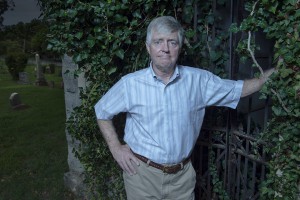Immortal, seductive, bloodthirsty—and sometimes just plain sparkly—the vampire is here to stay
by Kayla Bates
Whether people are drawn to vampires because they are mysterious or symbolize power and sexuality or even because they represent an escape from mortality, the popularity of vampire stories doesn’t seem to be slowing down. With movies and TV series like True Blood, Twilight, and Vampire Diaries, as well as novel after novel about these undead creatures in bookstores, vampires are unlikely to fade as a source of public fascination anytime soon.
Stories of vampires reach back before written language. Jimmie Cain, MTSU professor, Bram Stoker scholar, and author of Bram Stoker and Russophobia, suggests the archetype of a creature that dies and comes back to life stems from people falling into cataleptic states—a condition characterized by a trance or seizure with a loss of sensation and consciousness accompanied by rigidity of the body. Today, we call these states comas.
“In the past, people didn’t know,” Cain says. “They thought when you fell into a coma that you were dead. Vampire stories likely come from stories of people that were dead, were buried, and then found around town in their burial gowns, covered in blood because they had to dig their way out of a grave.”
The modern-day vampire story was born toward the end of the 19th century with Stoker’s publication of Dracula. Dr. Cain suspects the grandfather of fang lit would be rolling over in his own grave about what has happened to the vampire tale in modern culture.
“If he were alive today, Bram Stoker would be horrified by True Blood, a show that valorizes vampires, and Twilight, where we have a vampire hero,” Cain says. “For Stoker, the vampire was a distillation of every conceivable form of evil imaginable: religious, spiritual, domestic, sexual, and I’d argue political evil, as well.”
By comparison, the character of Edward Cullen from Twilight is more inclined toward true love than true blood. Modern interpretations clearly highlight more humanistic qualities in vampires than do the older tales.
Cain says this trend toward warmer, fuzzier vampires actually has its roots in the 1970s and movies featuring actors such as George Hamilton (Love at First Bite) playing a debonair, sophisticated vampire.
That trend itself can be attributed to Anne Rice’s influential 1974 book, Interview with the Vampire, whose central character, Lestat, while still quite monstrous, was nonetheless the protagonist (and one with whom readers could sympathize, at that).
Another theme recurrent in vampire stories that has morphed over time is the liberation of women. In the Dracula story, the women who are turned to vampires immediately become sexual.
“These turned women lose all the demeanor and probity of a proper Victorian woman and suddenly become sexually rapacious,” Cain says.
While we don’t see Bella Swan instantly changed into a woman hunting for sexual experiences, Stephanie Meyer, author of the Twilight saga, does portray the newly vamped Bella as a wickedly beautiful, almost eerily perfect physical manifestation of a woman. The concept of beauty and eternal youth clearly resonates in a modern society seemingly obsessed with staying young.
Cain speculates that in addition to our desire to remain young and beautiful forever, the rise in popularity in vampire stories could be linked to the increasing number of people who have lost their belief in an afterlife.
“If there’s no heaven, maybe the next best thing is to live forever,” Cain says.
One thing hasn’t changed, regardless of era: though the vampire craze is a little long in the fang when it comes to its role in popular culture, the public’s appetite for a good vampire tale seems unabated. And even as undead creatures such as zombies have shambled into the spotlight, vampires are here to stay.


COMMENTS ARE OFF THIS POST